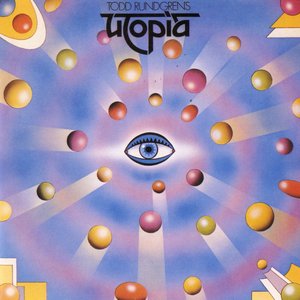Published on May 7, 1998
Back in 1974, the world already had a band mired in wretched
excess – they were called Yes. Todd Rundgren should have realized
that he didn’t have to create an American version of that
excess.
While Rundgren had been enjoying success with a solo career, he
either felt a need to be part of a band again (instead of being the
studio
wunderkid doing everything himself), or he wanted to catch
the tail end of the progressive rock scene. Whatever the case, the
end result was Utopia, and their debut release
Todd Rundgren’s Utopia is a serious slap in the face to
those expecting the happy, poppy sound of Rundgren’s solo days.
It’s a change, all right – and it’s not one for the better.
You almost know you’re in trouble when you look at the album and
see only four songs on the whole platter – including a 30-minute
monstrosity called side two. Uh-oh. Funny thing is, during the
pompousity of some of these tracks, you hear the undercurrent of
the rock-and-roll monster waiting to burst forth and take control
of the band. They’d eventually turn to more conventional music, but
for now, prog rock was the thing for them, and they make all the
same mistakes the big bands of their time did.
In one sense, they do one thing correctly: they don’t always
take themselves so seriously. Rundgren still knows how to laugh at
people, evidenced on “Freak Parade”: “In a world full of freaks /
You can creep, you can crawl / But the world’s biggest freak / Is
the one with no balls.” Unfortunately, moments like these aren’t
common on
Todd Rundgren’s Utopia.
Whether it’s the 14-minute birth cry of the band (recorded live
in Atlanta) on “Utopia,” or the side-long “The Ikon,” the greatest
limit of progressive rock is plainly heard: the moment you decide
the instrumental development is more important than the song, the
whole thing falls apart. And at least on “The Ikon,” you can still
hear glimpses of Rundgren the solo artist in his guitar solos. But
frankly, I think they stretched things
way too far when they threw in some country-tinged bits at
the end. (Mike Oldfield tried this back on
Tubular Bells – it didn’t work.)
Ironically enough, the one short song on this album, “Freedom
Fighters,” doesn’t work as well as “Freak Parade,” which clocks in
at 10 minutes. The difference? Song development. “Freak Parade”
contains some good performances (such as the work of keyboardist
Moogy Klingman and the synthesizers of M. Frog Labat – as well as
Kevin Ellman’s trap work), and the song is more solidly crafted.
Granted, it’s not perfect, but it’s a far cry better than the
orgasmic chord crunching at the beginning of “Utopia”.
Of course, I realize that Rundgren’s career lends itself to a
“love-it-or-hate-it” attitude due to his stylistic changes from
album to album, and that what I think is a questionable sidestep
might be revered by other people. (Hell, I’m the one that liked
No World Order, for Crissakes.) If you like progressive
rock, you’ll probably be quite intrigued by
Todd Rundgren’s Utopia, while those looking for another
“Bang The Drum All Day” will turn this one off in disgust.
I guess that, in the end,
Todd Rundgren’s Utopia was an album worth experiencing, but
I sure as hell am not looking forward to listening to it again.
